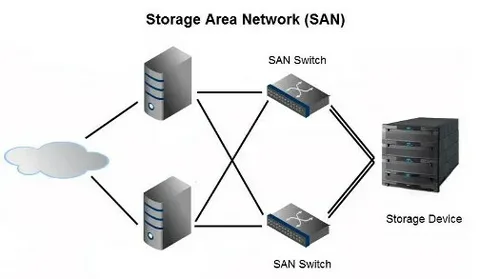The storage area network (SAN) market is expected to grow steadily from 2025 to 2035, driven by increasing demand for high-speed data storage, enterprise cloud infrastructure, and AI-powered storage management solutions. It is projected to reach USD 23.01 billion in 2025 and expand to USD 33.12 billion by 2035, reflecting a compound annual growth rate (CAGR) of 3.7% during the forecast period.
In a world obsessed with cloud migration, edge computing, and AI-powered data lakes, the humble Storage Area Network (SAN) often operates in the background—quiet, stable, and invisible to most. But for enterprises managing mission-critical workloads, high-speed databases, and round-the-clock operations, SAN remains the gold standard of performance, reliability, and control.
More than just a storage solution, SAN is the engine room of modern data centers—designed to handle massive data throughput, minimize latency, and deliver uninterrupted access in environments where downtime is not an option.
Get Ahead with Our Report: Request Your Sample Now!
https://www.futuremarketinsights.com/reports/sample/rep-gb-802
Beyond Basic Storage: A High-Speed Highway for Data-Centric Enterprises
Unlike traditional network-attached storage (NAS) or local drives, SANs create a dedicated, high-performance network specifically for storage traffic. This separation allows for faster data transfer, reduced bottlenecks, and the ability to scale I/O-intensive applications without compromising performance.
From financial institutions processing thousands of transactions per second to healthcare systems handling real-time imaging and records, SAN provides the speed, capacity, and resilience that enterprise-grade data environments demand.
Built for Virtualization and Business Continuity
As virtualization, containerization, and hybrid IT architectures become the norm, SAN has evolved to support increasingly complex workloads. Modern SAN solutions integrate tightly with hypervisors, orchestrators, and backup systems—delivering the performance and flexibility needed to power virtual machines, databases, and enterprise applications around the clock.
High availability and redundancy are also built into the DNA of SAN architectures. With multi-pathing, failover clustering, and advanced RAID configurations, SAN ensures that data remains available even during hardware failures or maintenance windows—critical for sectors like finance, manufacturing, and telecommunications.
Centralized Control in a Decentralized World
While edge computing and distributed data strategies are on the rise, centralizing storage remains essential for data governance, compliance, and security. SAN enables centralized management of terabytes—or petabytes—of data, with enterprise-grade control over access, encryption, replication, and retention policies.
This makes SAN a key asset in regulated industries and large-scale enterprises that must meet strict data handling standards while maintaining operational efficiency.
Evolving with NVMe, Flash, and Automation
The SAN landscape is far from static. Flash storage and NVMe-over-Fabrics are pushing SAN performance into new territory, dramatically reducing latency and increasing IOPS for applications like AI training, high-frequency trading, and real-time analytics.
Automation and intelligent storage management are also gaining traction—allowing IT teams to monitor performance, predict failures, and optimize storage allocation dynamically. These advancements ensure that SAN remains relevant in modern IT strategies, even as the technology stack becomes more complex and dynamic.
Exhaustive Market Report: A Complete Study
https://www.futuremarketinsights.com/reports/storage-area-network-san-market
Private Cloud’s Silent Strength
While public cloud storage offers scalability and convenience, many organizations still rely on private or hybrid cloud strategies to meet their performance, security, or cost requirements. SAN plays a foundational role in these environments, enabling private cloud infrastructure with the performance consistency, data sovereignty, and customization that many enterprises demand.
Whether deployed on-premise or integrated into multi-cloud frameworks, SAN continues to provide a level of control and confidence that is difficult to match in public storage offerings.
Still Standing Strong in a Shifting Landscape
As digital transformation accelerates and workloads become more data-intensive and distributed, Storage Area Networks remain a critical enabler of enterprise resilience. They’re not just surviving the evolution of IT—they’re powering it, behind the scenes.
In a future defined by speed, scale, and security, SAN proves that sometimes the most essential technologies are the ones you never see—but always rely on.






